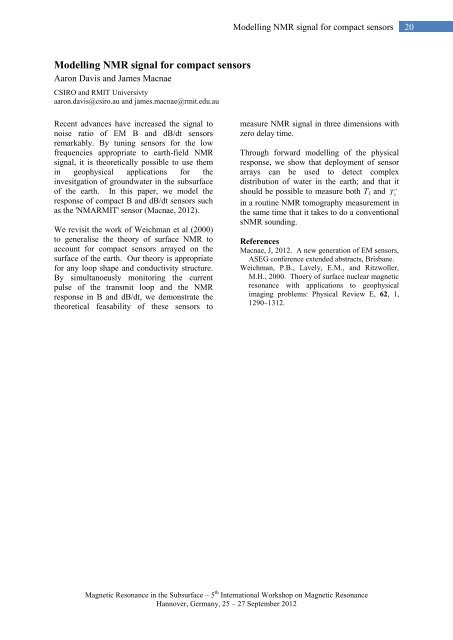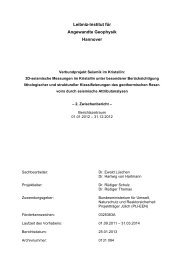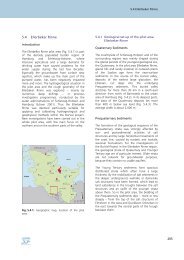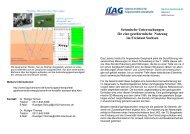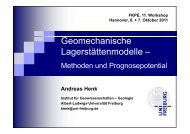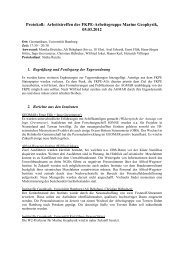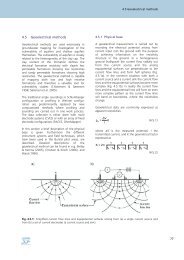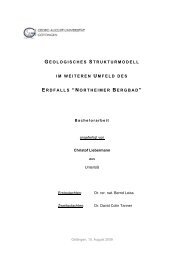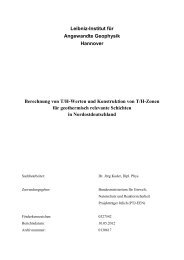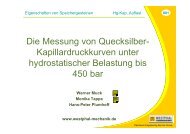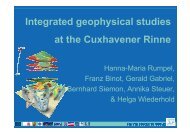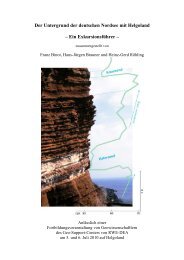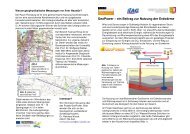Magnetic Resonance in the Subsurface – 5th International ... - LIAG
Magnetic Resonance in the Subsurface – 5th International ... - LIAG
Magnetic Resonance in the Subsurface – 5th International ... - LIAG
Create successful ePaper yourself
Turn your PDF publications into a flip-book with our unique Google optimized e-Paper software.
Modell<strong>in</strong>g NMR signal for compact sensors<br />
Aaron Davis and James Macnae<br />
CSIRO and RMIT Universivty<br />
aaron.davis@csiro.au and james.macnae@rmit.edu.au<br />
Recent advances have <strong>in</strong>creased <strong>the</strong> signal to<br />
noise ratio of EM B and dB/dt sensors<br />
remarkably. By tun<strong>in</strong>g sensors for <strong>the</strong> low<br />
frequencies appropriate to earth-field NMR<br />
signal, it is <strong>the</strong>oretically possible to use <strong>the</strong>m<br />
<strong>in</strong> geophysical applications for <strong>the</strong><br />
<strong>in</strong>vesitgation of groundwater <strong>in</strong> <strong>the</strong> subsurface<br />
of <strong>the</strong> earth. In this paper, we model <strong>the</strong><br />
response of compact B and dB/dt sensors such<br />
as <strong>the</strong> 'NMARMIT' sensor (Macnae, 2012).<br />
We revisit <strong>the</strong> work of Weichman et al (2000)<br />
to generalise <strong>the</strong> <strong>the</strong>ory of surface NMR to<br />
account for compact sensors arrayed on <strong>the</strong><br />
surface of <strong>the</strong> earth. Our <strong>the</strong>ory is appropriate<br />
for any loop shape and conductivity structure.<br />
By simultanoeusly monitor<strong>in</strong>g <strong>the</strong> current<br />
pulse of <strong>the</strong> transmit loop and <strong>the</strong> NMR<br />
response <strong>in</strong> B and dB/dt, we demonstrate <strong>the</strong><br />
<strong>the</strong>oretical feasability of <strong>the</strong>se sensors to<br />
Modell<strong>in</strong>g NMR signal for compact sensors<br />
measure NMR signal <strong>in</strong> three dimensions with<br />
zero delay time.<br />
Through forward modell<strong>in</strong>g of <strong>the</strong> physical<br />
response, we show that deployment of sensor<br />
arrays can be used to detect complex<br />
distribution of water <strong>in</strong> <strong>the</strong> earth; and that it<br />
*<br />
should be possible to measure both T1 and T 2<br />
<strong>in</strong> a rout<strong>in</strong>e NMR tomography measurement <strong>in</strong><br />
<strong>the</strong> same time that it takes to do a conventional<br />
sNMR sound<strong>in</strong>g.<br />
References<br />
Macnae, J, 2012. A new generation of EM sensors,<br />
ASEG conference extended abstracts, Brisbane.<br />
Weichman, P.B., Lavely, E.M., and Ritzwoller,<br />
M.H., 2000. Thoery of surface nuclear magnetic<br />
resonance with applications to geophysical<br />
imag<strong>in</strong>g problems: Physical Review E, 62, 1,<br />
1290<strong>–</strong>1312.<br />
<strong>Magnetic</strong> <strong>Resonance</strong> <strong>in</strong> <strong>the</strong> <strong>Subsurface</strong> <strong>–</strong> 5 th <strong>International</strong> Workshop on <strong>Magnetic</strong> <strong>Resonance</strong><br />
Hannover, Germany, 25 <strong>–</strong> 27 September 2012<br />
20


